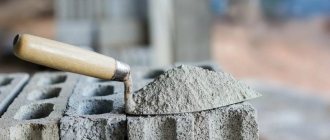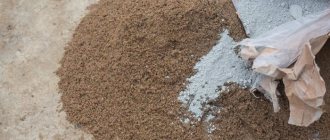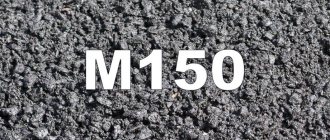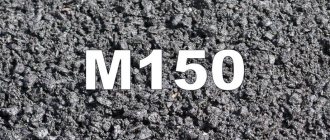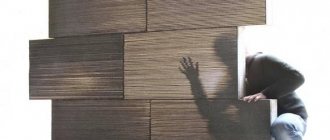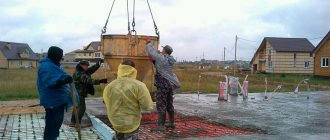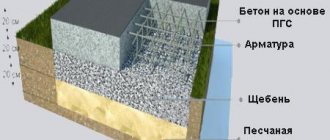As you know, concrete consists of 4 main components - cement, sand, water and coarse aggregate (crushed stone, gravel, pebbles, expanded clay, etc.). The composition can be improved with various additives (plasticizers, water repellents, antifreezes) in order to improve the performance properties of the building material. However, it is possible to use concrete mortar that does not contain filler. The scope of use of such a mixture is regulated in accordance with GOST.
Tools
At home, a concrete solution is usually prepared manually for commercial buildings, but when building housing, this procedure must be approached very responsibly.
The main rule for preparing the solution: the grade of cement should be 2 times higher than the grade of concrete that is needed for pouring. Those. if M150 concrete is needed, then the cement must be at least M300.
For cushions under the foundation and preparation of work in dry soils, use a solution of B7.5 (M100) with a rigid consistency. Crushed stone 5–20 mm is used as filler. Stairs, steps are made from the same concrete, but more plastic, fences, paths, etc. are poured. For the same purposes, in wet soils it is recommended to prepare hard concrete B10 - B12.5 (M150). Both the subfloor and paths are made from a mixture of a hard consistency of this brand.
For laying a strip foundation and unloaded parts of a building, a rigid mortar B15 (M200) or B20 (M250) is suitable. It is the same, only a little more plastic, suitable for cesspools, settling tanks, and septic tanks. For the foundation of a good residential building, you need to make concrete M300 (B22.5): this will be the best option and it is better to take crushed stone in fractions of 20–40 mm.
Concrete grades M350 (B25) and M500 (B40) are used for high-rise buildings, heavy-duty structures, storage facilities, laying runways and are not used in home construction - there is no need, and it is difficult to work with such a solution.
To mix the solution you will need:
Tips for using old bricks
After a major renovation in a private house, the question arises: how to use old brick? Many people don’t find the answer and throw away the old brick. However, this is the wrong decision. Broken bricks can be used in a variety of situations.
Don’t rush to throw old brick into a landfill; it can be used for paving paths, filling holes, making flower beds and fountains.
What to do with old brick
After construction work, broken or old bricks always remain. It can be thrown away or used for household needs:
- as a basis for the foundation;
- paving paths;
- bench construction;
- erection of a barbecue;
- landscape design;
- as a facing material for cesspools and cellars;
- for filling holes on a country road.
Foundation base and path made of old bricks
Broken bricks are used as a basis for construction work. Most often, broken building material is used in the construction of a fence foundation. Instead of crushed stone, broken bricks are poured or laid into the dug trench under the foundation. Next, sand is poured in and a small layer of concrete is poured. Next, crushed stone is poured and reinforcement or metal rods are laid out. Experts advise using broken building material only for the foundation for a fence or small outbuildings, such as a toilet, because when building a house, the walls and roof will put pressure on the foundation. The building material will crumble, which can lead to cracks in the foundation.
At the dacha, old bricks will come in handy when paving a path in the ancient Roman style. For these purposes, you can use both whole and broken building materials. It is best to use red because it looks impressive. You will also need sand, small crushed stone and construction tools. Start by marking the future path. Next, along the length of the entire path, a layer of soil about 20 cm thick is removed. Crushed stone is poured onto the bottom, and sand is placed on it and everything is thoroughly compacted. Next, they lay out the brick, alternating broken with whole. Bricks must be compacted as much as possible. The cracks between them are filled with sand. To prevent grass from growing between the building materials, it is necessary to put a film on a layer of sand and carefully stretch it so that the water does not stagnate after rain.
Brick bench and brick grill
Old brick can be used to build a bench. It can be installed on concrete or soil. A column of 5-6 bricks is laid out on a compacted or cemented place, fastening them with cement mortar. For a bench 1.5 m long, a minimum of 3 posts is required. Metal corners are laid on top of the posts, which also sit on the concrete. The columns must dry for at least 2 days. Next, sanded boards are screwed to the corners and coated with varnish or paint.
Broken bricks can be used to build such a useful device in the country as a barbecue. The building material is an ideal material for a barbecue because it heats up quickly and maintains the temperature for a long time. The construction of this structure begins with digging a hole along the previously measured perimeter. The hole is filled with broken building materials or crushed stone, which are compacted. Next, the hole is filled with cement mortar and carefully leveled. The foundation should dry out for several days.
Brick bench.
Next, building materials are laid around the perimeter, secured with cement mortar. We leave a small hole in one wall, which will be used for storing firewood or raking out heat. Each brick must be aligned using a level to avoid misalignment. Having laid out 5 rows, we install a metal grate or steel rods, on top of which 2 more rows of bricks are laid.
The width between the walls of the grill should be less than the length of the skewer. Next, a canopy is built over the barbecue to protect from precipitation. For the construction of barbecue walls, it is recommended to use only whole bricks and a minimum amount of mortar. You should not add a lot of cement between broken building materials, because under the influence of high temperatures it will crack.
Flowerbed made of old bricks
Old brick in the country house can be used for landscaping. To do this, you need to dig a hole of the required size. Cover its bottom with a mixture of sand and small gravel.
Components
Before preparing concrete, you need to carefully control the quality of the components.
The water should be as clean as possible, without impurities, dirt, clay, or soil. You cannot take wastewater from swamps, stagnant springs, or chemically contaminated wastewater. The solution simply will not set well. On average, water needs half the mass of cement.
Never add water to a ready-made solution.
Filler
There is a fine filler - sand, and a coarse filler - gravel, crushed stone. For light mixtures - expanded clay filler, slag, brick or limestone crushed stone. There is a rule: the strength of a coarse filler is two to three times greater than the design strength of the finished mortar. Crushed stone creates a kind of power skeleton for the mixture.
The filler should be as clean as possible, without soil, branches, soil, and especially clay. It is sometimes washed and sieved at the construction site. Allowable amount of impurities: 35% for crushed stone, 5% for sand. Organic impurities destroy the solution from the inside. It is recommended to sift, rinse and dry the filler before use.
Sand
It is advisable to take coarse sand, it is more versatile. There are 5 groups of sand: from 3.5 mm - with large grains; up to 1.2 mm – fine-grained. Builders recommend the latter only for lightweight concrete.
Checking the contamination of sand: 200 ml of it is poured into a bottle, water is poured, shaken, and poured out. Water carries away impurities; volume loss of more than 5% is poor quality. When mixing, take into account that dry sand contains 1% moisture, after rain - 10%.
Crushed stone
The fractions used are small (up to 12 mm, up to 40 mm). Granite screenings or chips are taken for floor screed and non-volume work.
The most popular fractions: 5–20, 5–10, 10–20, 20–40 mm. The size of the material should not exceed a third of the width of the product in the narrowest part and 2/4 of the distance between the reinforcement. Crushed stone larger than 150 mm is not recommended.
It is advisable to use two fractions - fine (at least a third of the coarse aggregate) and coarse - this will make the concrete denser. Pebbles are categorically undesirable: they are smooth and do not bind the solution well. Expanded clay (3–5 cm in size) is suitable for light screeds in houses with wooden floors.
Classification of sand concrete
In addition to the brand, sand concrete is classified according to the size of the sand grains used to make the mortar. There are three main types of cement-sand mixture:
- fine-grained (sand with grains up to 1.2 mm is used);
- middle fraction (sand granule size does not exceed 2.5 mm);
- coarse-grained (parameters of sand grains vary from 3 to 4 mm).
The most popular is considered to be sand concrete with the addition of middle fraction sand, the purpose of which is the production of solutions for pouring concrete floor screed, the production of steps, etc. A little less often, a coarse-grained mixture is used, used mainly for the construction of lightly loaded foundations and the construction of plinths with additional reinforcement. Fine-grained DSP is practically not in demand.
Cement. Rigidity
We will consider the characteristics of cement separately in close connection with the determination of its quantity in the mixture. Proper preparation of concrete is based on a harmonious ratio of components. Concrete must be used all at once - it is never left “for later”, so the amount of mixture must be carefully calculated.
Rigidity
Rigidity is determined by slipping: if the mixture flows from a horizontal plane, it is too liquid, plastic; when sliding when tilting - medium-plastic; if it sticks without slipping, it is low-plastic; does not settle, remaining a lump - hard. Liquid concrete is easier to lay, but hard concrete is better in quality and strength.
For reinforced structures, not very hard concrete with fine and medium aggregate is recommended.
Cement
The most popular brands of cement for private construction are M400, M500.
Table - Composition of concrete mixture per 1 m3 of concrete:
| Brand of solution | Share in kg. | |||
| Cement (M400) | Crushed stone | Sand | Water in liters | |
| M75 | 170 | 1053 | 945 | 210 |
| M100 | 210 | 1080 | 870 | 210 |
| M150 | 235 | 1080 | 855 | 210 |
| M200 | 286 | 1080 | 795 | 210 |
| M250 | 332 | 1080 | 750 | 215 |
| M300 | 382 | 1080 | 705 | 220 |
So, the amount of material M400 for 1 cubic meter of mixture:
The main quantity of cement sold on the market is Portland cement M500. If it is taken, then the above norms must be multiplied by 0.88. This and the following formula will be useful for purchasing the required amount of cement. The length, width, depth of the foundation is multiplied - the volume (cubic capacity) is obtained, based on the above proportions, you can find out exactly how much cement is required.
Nuances
Cement at home is often taken from stale cement, from leftovers from other construction. It must be taken into account that such a material does not have the necessary properties. To prepare the solution, you need dry, not expired material without lumps - this way the concrete will not crack. The shelf life of cement in original packaging is 90 days, in open packaging - no more than a week for dry conditions and no more than a day for wet conditions. The stale material must be thoroughly crushed with a hammer.
To prepare the solution manually, the popular grades of concrete are M100 - M350. All calculations are carried out by weight and are based on the mass of cement. The ratio of ingredients is calculated as their weight ratio to it.
Necessity of Limestone
When cement hardens, it turns into stone, but the stone is not extremely strong, prone to deformation, with large shrinkage of up to 2 mm. The value is naturally small, but due to the impossibility of controlling the uniformity of shrinkage actions, these 2 mm cause internal stress and microcracks, which reduce the durability and strength of the cement stone. Therefore, in order to avoid the threats outlined above, fillers are added to the composition: large (granite, gravel) and small (sand).
They are designed to create a structural basis for relieving shrinkage stresses, increase the elastic modulus of the consistency and its strength, reduce the deformation of structures, and reduce creep. In addition, sand, granite and gravel reduce the cost of concrete. It is better to use all fillers washed and free of impurities that can adversely affect the strength of structures. To make the consistency you will need:
Limestone is widely used in construction for the production of reinforced concrete slabs, floors, base blocks, crossbars and columns. Middle fraction aggregates are better suited for mortar. It is better to use especially small stones for filling cavities, and large fractions will increase the grip strength. The shape of the crushed stone is also of great importance: cuboid, lamellar and needle-shaped. The 1st form helps to increase the intergranular density in the solution; the composition with it is the strongest. For good adhesion and strength, it is better that the crushed stone or gravel contains less than 15% by weight of needle-shaped and lamellar stones. The solution may contain several fractions of granite or gravel. The main thing is to mix them well and distribute them moderately according to consistency.
Handmade recipe
Let's consider the option of how to prepare a concrete mixture for home construction manually, based on the proportions in the tables. Here are two tables, using which you can determine the proportions and number of components for 1 cubic meter of solution.
Table of water-cement ratio (average indicators of aggregates):
Table - Ratio of water and cement
| Concrete, brand | V/C | |
| Cement M400 | Cement M500 | |
| 100 | 1.04 | — |
| 150 | 0.86 | — |
| 200 | 0.70 | 0.80 |
| 250 | 0.58 | 0.66 |
| 300 | 0.54 | 0.62 |
Calculation of water for filler per cubic meter. m and the percentage of sand in it.
Table - Ratio of sand, crushed stone and water
| Crushed stone, mm | Volume of sand in% in solution | Water per cubic meter, in l. |
| 10-12 | 54 | 231 |
| 15 | 51 | 221 |
| 20 | 48 | 201 |
| 25 | 45 | 196 |
| 40 | 42 | 186 |
| 50 | 40 | 178 |
| 70 | 36 | 168 |
You also need to know the approximate density of the fillers, weight in kg/m2:
Preparation of concrete M300 (1 cubic m). Ingredients:
The first table determines W/C - 0.54; the second is the amount of water, with this filler you need 196 liters. Cement: 196/0.54=363 l. Volume and percentage of filler: 1- ((363/3000)+0.196)=0.680 m3. We look at the percentage of sand according to the second table - 45%, which comes out to 680 × 0.45 = 306 liters of sand. Crushed stone: 680–306=374 l.
The volumes were determined in liters, so you can work with a 10 liter bucket. If the supplier measures fillers in tons, then it is easy to convert them into liters using the above weight-volume density values in kg/m2 (for cement you need to take the bulk density).
Other popular recipes and proportion options
The generally accepted proportions for preparing concrete at home are: 1 (C)/4 (W)/2 (P)/0.5 (V). In weight terms, it looks like this: 300/1250/600 kg, water - 180 liters.
If you take M400 cement, you will get M250 concrete, if you take M500 cement, then you will get M350 mortar. For mortars of low grades, it is necessary to reduce the cement content. For solution B20 (M250) there is another recipe: 1 (C - M500) / 2.6 (P) / 4.5 (Sh) / 0.5 (V) or in kg: 315/850/1050, water - 125 l per cubic meter m.
More proportions (cement: sand: crushed stone; water - half of cement):
Simple secret
There is a simple way to determine proportions. Crushed stone is poured into an empty bucket and distributed evenly. Using a measuring cup (1 liter jar), add water until its level is equal to the edge of the crushed stone. The volume of liquid is the required volume of sand.
Next, the crushed stone is poured out, and in its place the same can of sand is poured in the same amount as there was water. Then water is poured in again until it covers the sand. This is how the required volume of cement is determined. The last component is water, its amount is 50–60% of cement.
The method is based on the principle that sand fills the voids between the crushed stones, and cement fills between the grains of sand. In this case, the strength of the solution will be approximately the same as that of crushed stone. This method does not take into account the expansion of the filler grains or some other parameters, but it is simple and can be used for non-critical structures.
Mixing methods
The preparation of concrete mixture is carried out in two ways:
Manual kneading
Many people are mistaken in believing that mixing by hand requires a container - no, preparation is carried out using a board made of boards; they also use metal, tin boards, troughs made of various materials; the concrete mixture is mixed even just on a flat, hard surface. If the shield is constructed from boards, they need to be tightly fitted and, ideally, covered with roofing iron, although you can simply knead it on a sheet of such iron with the edges slightly turned inward.
First, sand is poured in a heap along the length of the shield, a furrow is made in the center, cement is poured there, the sand is rolled in little by little from top to bottom, stirring gradually. Next, sand and cement are mixed 3-4 times using two shovels, then everything is moistened with water from a watering can and mixed again. Next, gravel is poured evenly, the mixture is stirred at the same time, and water is added little by little until the required consistency is formed.
Another sequence: cement - water - sand - gravel (crushed stone).
Concrete mixer
There are two types of these devices: with a gravitational or a forced mechanism. The simplest and most accessible first. This is a pear with blades inside, rotating in an inclined position. It takes about 2-3 minutes of rotation to knead.
Preparation is carried out in stages - this way the concrete mixture is well mixed:
Everything is poured only into a horizontally standing (maximally inclined) bowl. The more horizontal the concrete mixer, the better. After unloading the concrete, the bowl must be washed with water so that there is no frozen solution on it. There are small mechanisms, they are convenient, but they can mix no more than 4 buckets of crushed stone at a time; if you load more, you won’t be able to tilt the bowl, and the batch will be of poor quality.
In winter, the order changes: first hot water, then crushed stone, cement, sand. Potash (potassium carbonate) and antifreeze additives are added to the solution, but you need to know when to stop, they destroy the reinforcement.
What kind of crushed stone is needed for parking?
Do parking
only granite crushed stone or river gravel is needed.
Crushed limestone
will turn the parking lot into a muddy mess at the first rain.
The bottom layer of the future parking lot
is covered with crushed stone with a fraction of up to 60 mm, and the top layer with a fraction of up to 20 mm. The fine upper fraction of the material will help fill voids and level the surface.
Interesting materials:
How to determine the naturalness of honey when purchasing? How to determine the naturalness of honey? How to determine whether honey is natural or not? How to determine the required thickness of insulation? How to determine histamine intolerance? How to identify a non-resident by tax identification number? How to identify a nervous breakdown? How to identify stainless steel by spark? How to identify stainless steel using copper sulfate? How to define an indeclinable noun?
Proportions of concrete from screenings and cement
Most people who want to build their own country house, cottage or garage are wondering about the price of the project. Affordable building materials will help you save. One of these is economical concrete made from screenings with sufficient mechanical parameters. Concrete is most widely used in the construction industry. Let's get acquainted with what is required for the production of concrete from screenings and cement proportions, what the proportions should be and what are the features of this filler.
Figure 1. Preparation of concrete mortar
Types of dropouts
Screenings are rocks that have been crushed and sorted by size. The concept of “screenings” also includes secondary processed building materials. It is popular due to its low price and availability. At the same time, this is an environmentally friendly raw material, harmless to human health, regardless of the size of the fraction. When compared with sand, it has the following advantages:
Screenings are classified by size and source material. The following sizes are common: 0.1 – 10 mm. In application, fractions of 1.5 – 4 mm are more common than others. The smallest elements are separated by washing out - they are laid out on a flat, solid plane and watered with water under pressure. The smallest particles are washed out of the total mass with a stream of water. What remains is suitable for further purposes.
If desired, concrete is made from screenings. The resulting solution is suitable for many tasks: construction of houses, reinforced concrete structures, construction of highways, and so on. Screening filler comes in several types: granite, concrete, concrete and brick.
Granite
It has become most widespread, primarily due to its high performance properties. Granite mortar from screenings allows you to make concrete of a high strength class. It is made from granite particles ranging in size from 0.1 to 1 cm. This screening is characterized by gray or red color.
Advantages and disadvantages
Concrete without crushed stone contains other fractions comparable in size to the crushed stone fraction (for example, expanded clay). In the simplest case, it is a cement-sand mortar, to which nothing is added except water. Some additives are added to modern concrete to act as improvers that increase its performance parameters. The advantages of concrete without crushed stone include low cost and availability, ease of preparation and use, wear resistance, and resistance to significant temperature changes of up to tens of degrees per day.
The disadvantage is that the strength of concrete without crushed stone is significantly inferior to conventional concrete containing solid gravel or crushed rock.
In addition, ready-made concrete, purchased from various distributors, is noticeably more expensive than a mixture prepared manually from ingredients purchased independently.
Preparation of concrete
You can make the solution yourself. The best way to do this is to use a concrete mixer. If this construction machine is not available, any container for preparing a future batch will do. To prepare concrete from screenings and cement, precise proportions must be observed in order to obtain the desired performance properties. Each component plays a significant role.
Figure 4. Preparation of concrete mixture
Proportions
The mixture is made taking into account many factors. Cement plays a significant role in mortar. To create a high-quality mixture, it is important to choose the appropriate brand of cement. Highly graded raw materials provide better adhesion of concrete to different surfaces.
It is important to observe the shelf life of cement, since, being unused, its performance properties are reduced. For example, after a month the strength decreases by 10%. There is a way to find out if the cement is suitable. To do this, scoop it into your palm and squeeze it. If the cement has a crumbly structure, then it will make a good solution. The marking of the material directly affects the price. But the higher the number next to the letter “M”, the better the performance of the cement.
The specific type of screening is chosen taking into account the level of loads that the coating will withstand. Temperature operating conditions are also important. The solution that was made from granite and cement will be cheaper. A more expensive option is mixing sand with crushed stone. An example where the task is to flood the yard. Here, an additional element is the reinforcing mesh. The thickness of the pouring layer is 7 cm. The granite-based mixture is prepared in the following proportion: cement M400 (1 part), screenings (8) and no more than 20% water. The prepared mass will have a strength of M150. Granite comes to the rescue if you need to pour a foundation. In the case of a yard, you will need a sand cushion. However, the latter easily replaces the screening itself, which is first compacted and then poured. The thickness here is required to be at least 5 cm.
The proportions of water play a significant role. The final mass should have a medium consistency, and this is what they start from when determining the amount of water. If there is too much of it, the structure of the mixture will be disrupted and will shrink greatly during use. This not only reduces the load-bearing capacity of the material, but also often leads to the formation of cracks. Water quality is also important. When producing high-strength concrete, enterprises use drinking water rather than industrial water.
The proportions for a mixture without sand were described above. It is not necessary to eliminate it completely; it is enough to replace it partially. But you will have to add crushed stone. The proportions will look like this:
Important! At this ratio, the added screenings do not increase the final volume of the mixture. Its auxiliary role is reduced to binding sand with crushed stone.
According to construction newcomers, the more cement you add, the stronger the concrete. This is a misconception: excess cement will only reduce the quality of the material. The only thing that matters here is the brand.
Preparation of the solution
If you plan to produce a large volume of concrete, it is more convenient and faster to work with a mixer. Not only is doing the job by hand more difficult, it will also affect the final quality of the product. All prepared components in the correct ratio are poured into a concrete mixer or a special container. Then they are mixed until a homogeneous mass is formed. Only at the end, and then in small portions, is it necessary to introduce water. At this stage, constant stirring is required. The mass and moisture content must be uniform - only this solution is ready for use.
The prepared mass should be used within the next two hours from the moment of preparation. Further, its properties will begin to be lost. It happens that moisture evaporates during kneading. You are allowed to add as much of it as is necessary to achieve the desired consistency. Often the mixture is made using already wet components - this can cause a decrease in the amount of water.
Figure 5. Adding water to the mixture
Construction crushed stone
Purpose and properties
The fine fraction is visible - crushed stone for concrete must be of a certain size.
Crushed stone is a mineral inorganic product of crushing rocks, gravel, boulders, mining waste, processing ores, slag from metallurgical plants and thermal power plants, as well as recycling construction waste. The stone must be free-flowing and have a fraction from 3 – 5 mm to 150 mm and above. Particularly large screenings are called bute (
How to make concrete with your own hands: choose instructions on how to make concrete correctly
Concrete mortar is the most important component in the construction of foundations, and the durability of the entire structure depends on its quality. It is not always possible to order a ready-made mixture, and therefore it is advisable to know how to make concrete with your own hands. Here it is important not only to maintain proportions, but to select the components correctly, otherwise the strength of the solution will not be high enough.
How to make concrete with your own hands
What happens if you place a concrete mixture without formwork in the ground?
Formwork when pouring the foundation is required to prevent the concrete from spreading and then being absorbed into the ground. In addition, it allows you to give the plastic solution the required shape, thickness and width. There is also special liquid concrete for leveling concrete floors. When constructing small structures, the formwork can be replaced with geotextile film with a thickness of at least 200 microns. It is laid on previously prepared trench walls, gluing all joints with tape.
This method allows you to avoid evaporation of concrete milk before hardening, maintaining the strength and shape of the foundation.
Characteristics of concrete
Strength
Concrete mortar is a mixture of cement, sand, filler and water in certain proportions, which vary depending on the purpose of the concrete and the brand of cement. If necessary, plasticizers are added to the solution. The most important characteristic of concrete is its compressive strength, which is measured in MPa (mega pascals). It is based on this indicator that concrete is divided into classes. But the grade of concrete indicates the amount of cement in the solution.
| Concrete class | Average strength of this class, kg s/sq.cm | Nearest brand of concrete |
| AT 5 | 65 | M 75 |
| B 7.5 | 98 | M 100 |
| AT 10 | 131 | M 150 |
| At 12.5 | 164 | M 150 |
| At 15 | 196 | M 200 |
| IN 20 | 262 | M 250 |
| At 25 | 327 | M 350 |
| At 30 | 393 | M 400 |
| At 35 | 458 | M 450 |
| At 40 | 524 | M 550 |
| At 45 | 589 | M 600 |
| At 50 | 655 | M 600 |
| At 55 | 720 | M 700 |
| At 60 | 786 | M 800 |
Concrete grades M100 and M150 (B7.5 and B12.5) are most often used as a layer under the main foundation, for the manufacture of screeds, and concreting paths. Concrete M200-M350 is most in demand: it is used in the construction of foundations, for the manufacture of screeds, concrete stairs, and blind areas. Mortars of higher grades are used primarily in industrial construction.
Basic characteristics of concrete
Plastic
An important characteristic of concrete is its plasticity. The more plastic the solution, the better it fills the formwork structure. When the mobility of concrete is low, unfilled areas remain in the screed or foundation, which leads to the gradual destruction of the concrete slab. For standard structures, concrete with plasticity P-2 or P-3 is used; for formwork of complex shapes and in hard-to-reach places, it is recommended to use a solution P-4 and higher.
Waterproof and frost-resistant
Water resistance depends on the amount and brand of cement in the solution. The higher the grade, the more resistant the concrete is to moisture. Frost resistance of concrete is achieved by adding plasticizers to the composition. It should be noted that such solutions set very quickly; if you incorrectly calculate the amount of the mixture or use it at a low temperature, the concrete will turn into a monolithic block right in the container.
Crushed stone and gravel are the most popular fillers for concrete
The main filler for all types of concrete is crushed stone or gravel - crushed rock. Crushed stone is most often used. It is also divided into fractions and has a rough, uneven surface.
When selecting the composition of concrete, you should also take into account that sea or river pebbles cannot serve as a substitute for crushed stone, since a smooth surface polished with water significantly impairs the adhesion of the stone to the other components of the mixture.
Crushed stone is divided into the following fractions:
Very small - 3 - 10 mm.
Small - 10 - 20 mm.
Medium - 20 - 40 mm.
Large - 40 - 70 mm.
To ensure that your concrete lasts for many years and does not collapse, you should remember that the maximum size of stones in crushed stone should not exceed 1/3 of the minimum thickness of the future product.
They also take into account such an indicator as the voidness of the filler - the volume of empty space between the crushed stones. It’s easy to calculate - take a bucket of known volume, fill it with crushed stone to the brim, and pour water into it using a measuring container. Knowing how much liquid has entered, we can calculate the voids of the crushed stone. For example, if a 10-liter bucket of crushed stone holds 4 liters of water, then the voidness of this crushed stone is 40%. The lower the voids of the filler, the lower the consumption of sand, and, importantly, cement.
To fill the voids as much as possible, different fractions of crushed stone should be used: small, medium, coarse. It must be taken into account that the fine fraction should be at least 1/3 of the total volume of crushed stone.
In addition to crushed granite and gravel, depending on the purpose of the concrete, expanded clay, blast furnace slag, and other artificial fillers are used. For lightweight concrete, wood shavings and crushed polystyrene foam are used. For ultra-light concrete – gases and air. However, the creation of light and ultra-light concrete is associated with a number of difficulties, and it is unlikely that it will be possible to correctly produce such a product outside an industrial workshop.
Depending on the density, all concrete fillers are divided into porous (3) and dense (>2000 kg/m3). Also, do not forget that natural fillers have a low radiation background, which is inherent in all granite rocks. Of course, this is not a source of radiation pollution, but it is still worth remembering this property of natural stone as a concrete filler.
Concrete components
Cement
Cement performs a binding function for all other components of the concrete mortar, and the strength of the concrete itself directly depends on its quality. In private construction, cement grades M400 and M500 are most in demand. When purchasing cement, you should be aware that it loses its qualities if stored for a long time or improperly. Already a month after production, the binding properties of cement decrease by 10%, after six months - by 50%, after a year it is not recommended to use it at all. But even fresh cement will become unsuitable for use if it becomes damp, so it must be stored in a dry place.
Cement
Sand
Sand is the second most important component of concrete mortar. In rare cases, it is replaced with slag, while standard concrete is always mixed with sand. It is best to use coarse river sand without various impurities. If only ordinary fine sand is available, it should not contain clay, earth or silt, which reduce the adhesion of the solution to the filler. Before mixing, the sand must be sifted to remove all excess.
Aggregate
The best filler for concrete mortar is crushed stone with dimensions from 5 to 35 mm. Often crushed stone is replaced with gravel, and a little less often with expanded clay. It is very important that the surface of the aggregate is rough, then its adhesion to the cement will be as strong as possible. To compact the mixture, you need to take aggregate of different fractions. Like sand, the aggregate must be clean, so it should be poured onto a prepared and compacted area or on a spread tarp.
Supplements
To give concrete frost resistance, water resistance and other useful properties, plasticizers are used. They ensure the setting of the solution at low temperatures, increase its plasticity or, conversely, impart viscosity. They should be used only if it is really necessary, and you should strictly adhere to the instructions for their use and observe the proportions.
Construction fiber
Steel fiber fiber
If a thin screed or a screed on an unstable base is required, reinforcing fibers are mixed into the concrete solution. They are made of polyvinyl chloride and polypropylene; they have low strength, but are excellent at avoiding cracking of concrete. In standard foundations and screeds, reinforcing substances are not needed.
Prices for cement and basic mixtures
Features and properties of concrete mortar without crushed stone
Concrete that does not contain coarse aggregates is called sand concrete. This mixture is made from 1 part cement and two parts sand and is used primarily for rough construction and repair work.
Sand concrete is most often used for:
- concrete floor screed devices;
- construction of plinths, steps, pillars;
- repair of existing structures.
Like ordinary concrete mortar, cement-sand mixture is classified according to strength grades. For example, to improve the floor in a garage or warehouse, it is recommended to choose sand concrete marked M300-M400, while M200 is also suitable for pouring floor screed in a bathroom or kitchen.
Among the main advantages of the building material, you should pay attention to:
- compressive strength (indicator depends on the brand of sand concrete);
- satisfactory resistance to cracking;
- resistance to vertical loads;
- long period of operation.
Solution proportions
To make high-quality concrete yourself, you need to know in what proportions to mix the components. Most often, the ratio of cement, sand and crushed stone is used as 1: 3: 6; In this case, half as much water is taken as the total weight of the dry ingredients. It is recommended to add water not all at once, but in several portions, this makes it easier to control the density of the solution. The humidity of the sand also matters - the higher it is, the less water is required. All components must be measured in one container, for example, a bucket. When using containers of different sizes, it will not be possible to achieve the desired proportions.
When mixing, the purpose of the solution should be taken into account. For the substrate under the screed, lean concrete is made without adding crushed stone, for concreting paths and blind areas, crushed stone of medium and fine fractions is used, for the foundation of a house, medium-fraction crushed stone and high-quality cement are used. The table will help you find out the exact proportions of different grades of concrete.
Preparation of concrete
Sand - what it is and what it is needed
Sand can also be different. Moreover, the final result directly depends on the quality of this component.
According to their granulometric composition, sands are divided into:
Thin (less than 1.2 mm).
Very small (1.2 - 1.6 mm).
Small (1.6 - 2.0 mm).
Medium (1.9 - 2.5 mm).
Large (2.5 - 3.5 mm).
All types of sand are used in the production of concrete, but if there is a lot of dust or clay particles in the sand, this can significantly deteriorate the characteristics of the mixture. This is especially true for fine sand, which contains a significant percentage of dust; it is of little use for preparing concrete and is used as a last resort.
How to prepare good quality concrete without making a mistake with sand? It's simple - you should use sea or river sand - these are the purest types of building materials that do not contain any dust particles or clay. It is necessary to ensure that the sand is clean and free of organic contaminants.
Quarry sand can be very dirty - it is often not used in construction without preliminary preparation, including washing and settling. It may also contain a lot of organic debris - roots, leaves, branches and tree bark. When such impurities get into concrete, voids may appear in the thickness, as a result of which strength suffers.
Another important parameter that needs to be taken into account is the moisture content of the sand. Even dry-looking material can contain up to 2% water, and wet material can contain up to 10%. This can upset the proportions of the concrete and cause a decrease in strength in the future.
Manual method of mixing concrete
Mixing the concrete solution is done manually or in a concrete mixer. If you need to fill a large area, the first method is not suitable, as it will take too much time and physical effort. If you need a little solution, it is more convenient to knead it by hand.
Step 1. Preparation
To prepare the solution, you will need a low, wide container, for example, a large metal trough, a picking shovel, a bucket and a regular hoe.
Container for preparing concrete
Preparation of concrete
Preparation of concrete
Step 2: Dry Mixing
A bucket of cement is poured into the container, then 3 buckets of sifted sand and 5 buckets of crushed stone. The dry ingredients are thoroughly mixed with a hoe. The proportions may be different, depending on the required brand of solution.
Step 3: Adding Water
If all ingredients are mixed evenly, you can add water. First, pour out 7-8 liters and begin to intensively stir the contents with a hoe. This process will require effort, but you need to stir it very well. It is advisable to lift the bottom layer and run the hoe into the corners where dry lumps may remain. If the solution is very thick and sticks to the hoe, you need to add a little water. Properly prepared concrete slides off the shovel slowly and does not delaminate.
There is another mixing option: first, water is poured into the container, then cement is poured. For 2 buckets of water you need 2 buckets of cement. Thoroughly mix the cement with water and add 4 buckets of sand. Mix well again until smooth. Lastly, add crushed stone in the amount of 8 buckets and mix again. There is no clear opinion on which method is better, so it’s worth trying both and determining the most optimal one for yourself.
Find out the correct proportions, how to make a solution for plastering walls with your own hands, from our new article.
Broken brick
The poured foundation often contains broken bricks. This is a secondary building material that remains after the dismantling of a brick or concrete structure. It is further detailed and sifted into fractions. Much cheaper than crushed stone and has good drainage properties. With its help, holes, potholes, ditches are filled up and swampy areas are strengthened. Not used in work that requires high quality materials.
What it is?
Broken brick is a secondary raw material for construction. Old concrete material can be used in other construction applications. When dismantling the foundation, the wall of the house receives a lot of construction debris, which has a second life and a hopeless existence. The scrap is obtained by crushing construction waste and crushed red brick. Performed manually or using heavy equipment. Instead of crushing yourself, you can hire a team that specializes in this function. Broken block has excellent drainage ability, which is why it is justifiably used in the construction of temporary roads, especially in field areas.
Broken bricks and broken concrete contain:
- fragments of bricks;
- crumbs of brick and concrete.
Includes silicate, fireclay, fireproof or any other material used in construction.
In small quantities, it is broken with sledgehammers; if large-scale use of the material is needed, then the old stone is processed in crushing machines. Subsequently, it is sifted into fractions. It replaces expensive materials in construction when high quality work is not required. Transported in bulk, in open vehicles. Does not require special storage conditions. Broken bricks are quite cheap (the price is indicated per cube of broken stone). Often it is sold by private owners. Rarely recyclable, more applicable in construction. Broken pieces 2-3 bricks wide are much cheaper than cleaned, crushed and sifted material.
Mixing in a concrete mixer
The concrete mixer is installed no further than 40 meters from the work site, preferably next to sand and crushed stone. This will allow the work to be completed faster and will facilitate the process of delivering the solution. Now you can start kneading:
Making concrete in a concrete mixer
If the resulting concrete is too thick, add a little cement to the remaining water, mix well and pour into a concrete mixer. It is not recommended to stir the solution for more than 10 minutes, otherwise the cement will begin to set. Ready concrete is poured directly onto the site or into a wheelbarrow if the concrete mixer is located at a distance. It is advisable to pour out the entire solution at once, but if this does not work, leave part of the mass in the turned on concrete mixer. It should be used as soon as possible.

